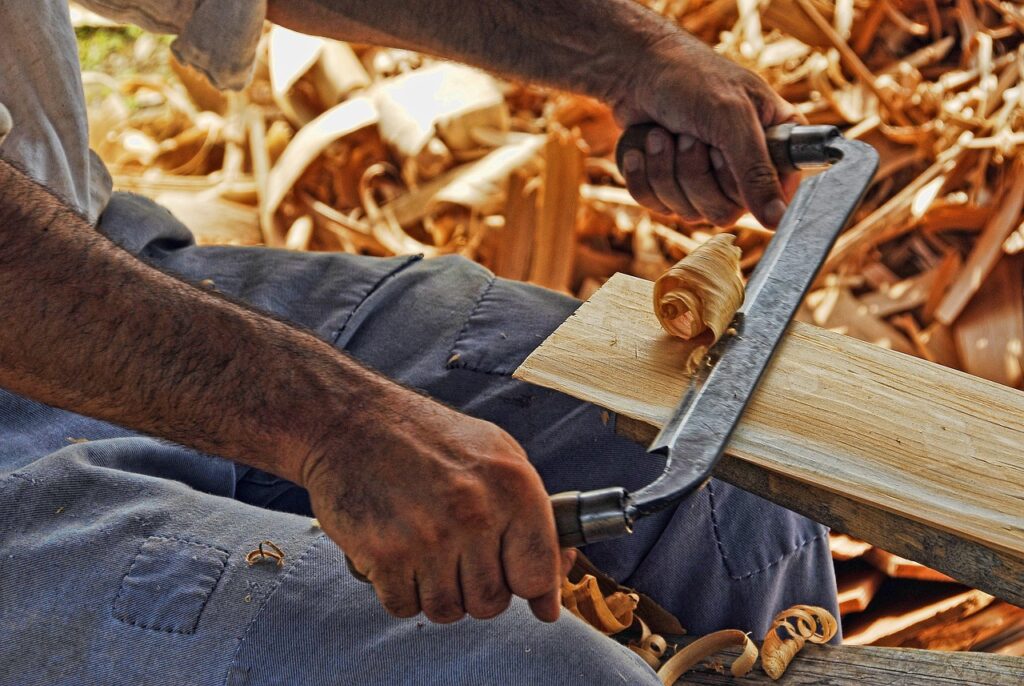
In a world of mass production, hand-crafted hardwood art stands apart. It’s a testament to human skill, patience, and a deep connection to a living material. Creating these pieces – from intricate carvings and flowing curves to rock-solid joinery – isn’t magic. It’s the marriage of vision, technique, and a carefully curated collection of hand woodworking tools. Forget the roar of machines; here, the whisper of a sharp blade through grain and the rhythmic scrape of a well-tuned plane create objects imbued with soul.
The Heart of the Craft: Why Hand Tools?
While power tools have their place, hand-crafted hardwood art emphasizes the dialogue between maker and material. Hand tools offer:
- Unparalleled Control & Feel: You sense every nuance of the wood’s density, grain direction, and texture, allowing for minute adjustments impossible with machines.
- Supreme Precision: A sharp chisel guided by a skilled hand can achieve fits and finishes exceeding most mechanical methods.
- Quiet & Contemplative Process: The focus required fosters a deep connection to the work, reducing dust and noise pollution.
- Respect for the Material: Hand tools remove wood gradually and intentionally, minimizing waste and honoring the tree’s legacy.
- The Signature of the Maker: Subtle tool marks become part of the piece’s unique character and story.
Essential Tools of the Hand Crafted Trade
Building beautiful hardwood art requires mastering fundamental tools:
- Measurement & Marking (The Blueprint):
- Precision Marking Tools: Marking gauges (cutting & marking), mortise gauges, cutting gauges, precision marking knives for razor-sharp layout lines (essential for clean joinery).
- Squares & Rules: Engineer’s squares, try squares, combination squares, steel rules – absolute accuracy is non-negotiable.
- Calipers: Digital calipers or dial calipers for exact measurements of thickness, depths, and joinery.
- Cutting & Shaping (The Transformation):
- Saws: Dovetail saws (fine joinery), tenon saws, coping saws (curves), Japanese pull saws (thin kerf, precision), Western backsaws. Choosing the right saw is crucial.
- Planes: The cornerstone of flattening, smoothing, and shaping. Bench planes (Jack, Fore, Smoothing), block planes (end grain, small work), shoulder planes (cleaning tenons), router planes (hollows, dados). A sharp, well-tuned hand plane is transformative.
- Chisels: Bevel-edge chisels (general paring, chopping), mortise chisels (heavy chopping), paring chisels (fine work). Sharp woodworking chisels are extensions of the maker’s hand.
- Carving Tools: Wood carving chisels (gouges, veiners, V-tools, skews), mallet (for driving chisels). Essential for sculptural elements.
- Spokeshaves & Drawknives: For shaping curves, chair legs, handles – removing material quickly along the grain.
- Scrapers: Cabinet scrapers and card scrapers – the ultimate finishing tools for a glass-smooth, tear-out-free surface without sandpaper.
- Joinery & Assembly (The Structure):
- Chisels & Saws: As above, for cutting mortises, tenons, dovetails.
- Routers (Handheld): Router planes for cleaning dados, grooves, and rabbets.
- Clamps: Bar clamps, F-clamps, pipe clamps, hand screw clamps, band clamps – you can never have too many for glue-ups!
- Mallets: Wooden mallets (for chisels), deadblow mallets (for assembly without marring).
- Finishing (The Revelation):
- Scrapers: For final surface perfection.
- Burnishers: For turning the burr on cabinet scrapers.
- Sanding Blocks (Optional/Minimal): Hand sanding blocks with high-grit papers, if used sparingly after scraping.
- Brushes & Rags: For applying oils, varnishes, or waxes that enhance the natural beauty.
Popular Products & Techniques in Hand-Crafted Hardwood Art
- Fine Furniture: Coffee tables, dining tables, chairs, cabinets – emphasizing dovetail joints, mortise and tenon joints, hand-planed surfaces, and intricate inlay.
- Decorative Bowls & Vessels: Often turned on a lathe but frequently finished with hand carving tools and scrapers for unique textures and forms.
- Sculpture & Carvings: Ranging from abstract forms to realistic figures, relying heavily on wood carving chisels and gouges.
- Boxes & Small Keepsakes: Jewelry boxes, humidors – showcasing precision dovetails, inlay, and flawless small-scale hand planing.
- Musical Instruments: Guitars, violins – demanding extreme precision in carving tops and backs, bending sides, and fretwork, often using specialized luthier tools (a subset of fine hand tools).
- Cutting Boards & Serving Trays: Functional art highlighting beautiful grain patterns, often featuring juice grooves and handles shaped with spokeshaves.
Mastering the Craft: Essential Techniques
- Sharpening: The most critical skill. Mastering sharpening stones (water stones, oil stones, diamond plates) and honing guides is non-negotiable. A dull tool is dangerous and ineffective.
- Grain Reading: Understanding how wood fibers run dictates the direction of every cut with a plane, chisel, or saw. Cutting against the grain causes tear-out.
- Hand Planing: Learning to set up a plane correctly, adjust the cut, and push or pull it smoothly to produce whisper-thin shavings.
- Sawing Techniques: Using the right saw stance, grip, and starting technique for controlled, accurate cuts.
- Chisel Techniques: Paring, chopping mortises, cleaning shoulders – control and leverage are key.
- Joinery: Practice, practice, practice! Mastering hand-cut dovetails and mortise and tenon joints is a hallmark of fine craftsmanship.
- Scraping: Learning to create and maintain a sharp burr on a cabinet scraper for that final, flawless surface.
